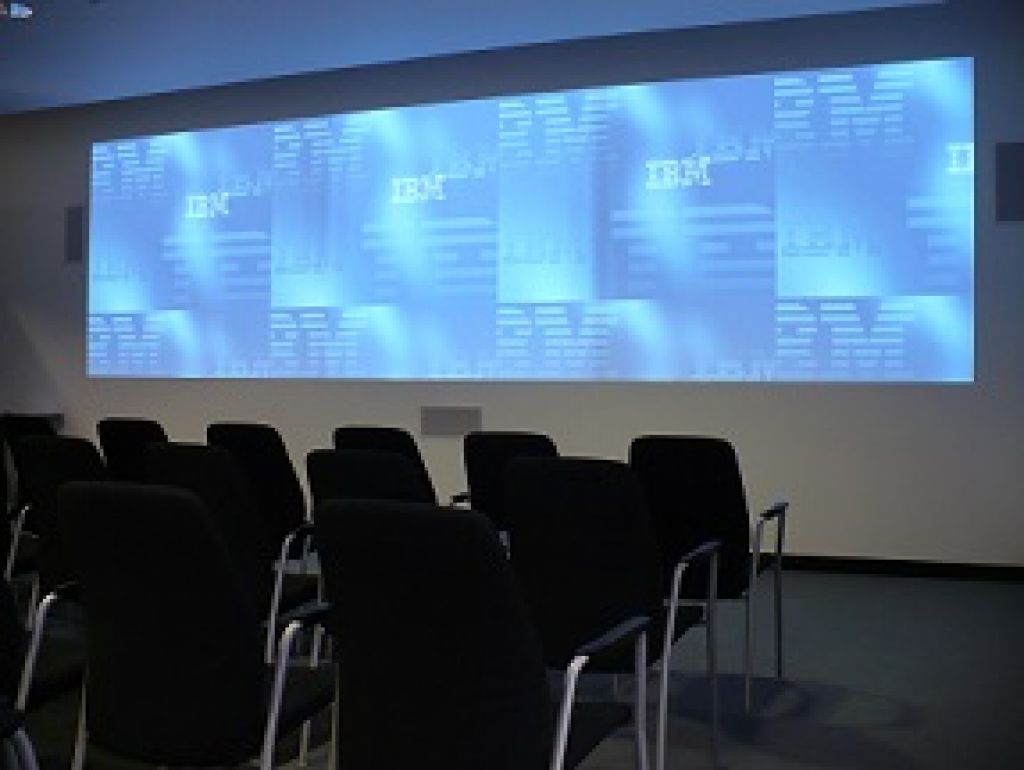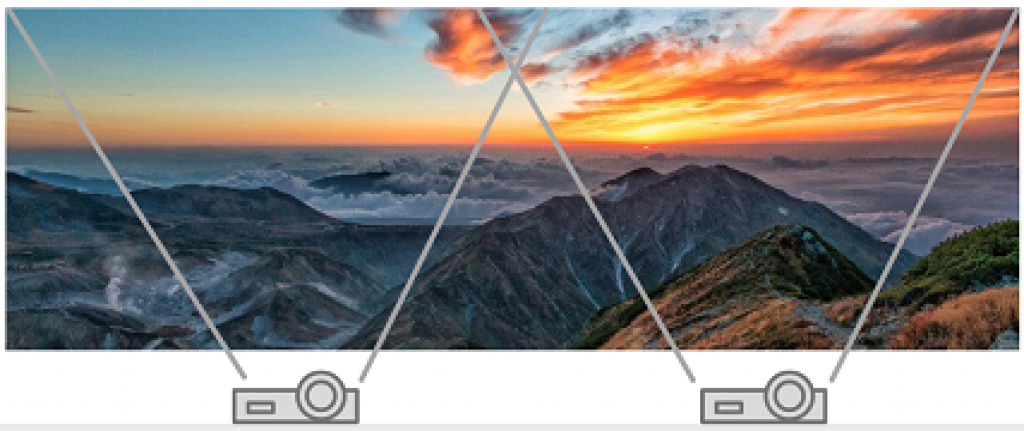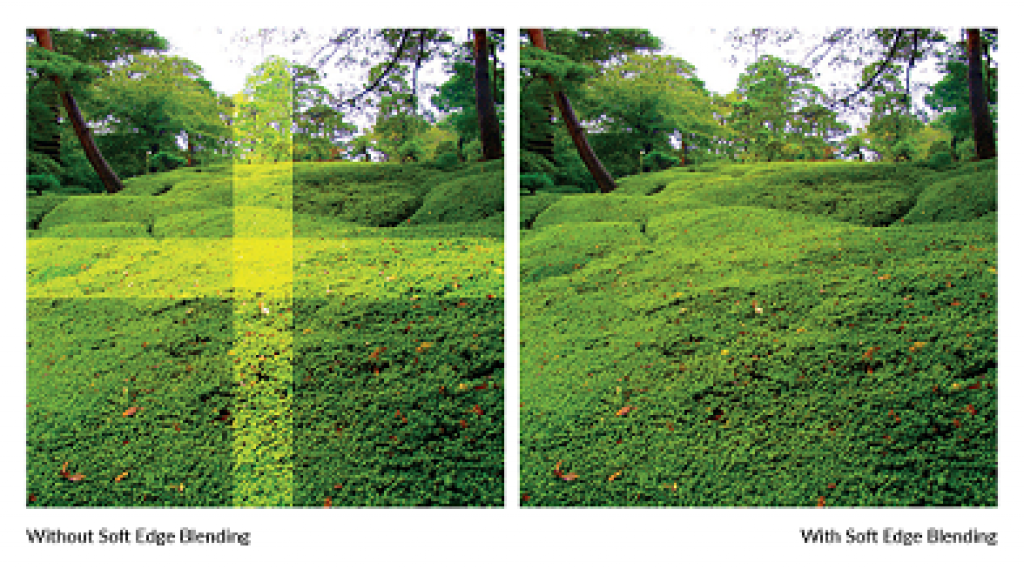What Is Edge Blending, How It Works?
What is edge blending, how it works?
Soft edge blending in the pro-AV industry refers to 2 or more projectors being used to display a section of the same video image. This is generally applied when a rather wide image needs to be displayed over a large area. The video or graphics content of the image must be displayed over a coherent surface where the audience shall not see the borders of the individual projectors.
They want to enjoy one big image of course, in razor sharp view and in real time without any disturbance. So, practically one or multiple videos must be projected by multiple beam projectors to a large surface as if this picture would come from a single projector.

Soft edge blending service of projector content can be proficient with either facilities built into projectors themselves or external video wall processors or controllers. Like the name of this function suggests, the edges of the two projects are to be blended together and then are softened along a smooth curve towards the edge. The projectors are also color balanced to make them match as closely as possible.
In order to provide a high-end visually mesmerizing experience to your audience, you will need to pick a leading-edge video processing solution that will be capable of combining multiple outputs for vertical as well as horizontal soft edge blending applications.
When and where edge blending is mostly used?
Why is it important?
The soft edge blending capability guarantees display of a wide and tall image while no gap can be seen between the individual screens. Sophisticated black level adjustment and easy-to-use gamma correction facilitate the setup of the projectors. Generally video wall controllers provide perfect solution to meet various project requirements in the following applications, where a large area must be mapped by beam projectors.
Generally such installations happen in the following application areas:
- Conference rooms
- Meeting rooms
- University campus and auditoriums
- Classrooms
- Control rooms
- Security supervision systems
- Staging and rental applications
- Show and demonstration rooms
The large picture can be broadcasted to the audience in such projects and so it can give the perfect visual experience when enjoying videos or movies in a large size. In control and supervision projects a large area is needed to display the sufficient amount of critical information and so this provides the opportunity for the operators to overview large and complex processes to easily supervise. The amount of information gives the feasibility of such AV project installations using multiple beam projectors.

IBM London UK, Training Room
How edge blending works?
When using a video wall controller with soft edge blending service, firstly the operator must use the gamma correction service in order to set up the colour uniformity of the video wall area. During this process he can define gamma correction, to each of the outputs one by one and they can simply set up a gamma curve to the outputs.
The next step is to define the overlapping areas of the neighboring monitors. In this environment, you can set any number of vertical and horizontal overlapping areas between the neighboring monitors. This process is supported by custom test pictures during the setup process.
Once this is completed, in the soft edge blending part you can define black level. This compensation means you have to set up the black level of the outputs and the overlapping areas of the projectors to the same level. This is an interactive process and need dark environment for a perfect tuning.

And now comes the most important step where you can configure the grey scale transition of the soft edge blending areas manually, using an advanced user interface. This user interface uses splines, by moving these you can adjust a special and different grey scale transition and check visually how this is displayed on the video wall in real life. The final result of this setup is perfect video surface.
The setting and calibration procedure needs interactivity and significant capacity but can give perfect solution to get the uniform area with real time display of graphics and video overlay information.
What are the most important factors of successful edge blending setup process?
Black level compensation for the precise brightness of projected screens
If using multiple beam projectors the black level of the different devices must be tuned to have the uniform brightness over the wall area.

Define overlapping screen area of neighboring beam projectors
The arrangement of the beam projectors can be easily set up in most user interfaces. After defining the arrangement customer can set up the size of overlapping screen between neighboring projector areas vertically and as well as horizontally. The size of the area must be defined in pixels but the usual size is minimum 25-30% of the single output resolution. Advanced test pictures support precise setting of overlapping areas.

Easy definition of grey scale transitions on the overlapping areas
Professional user interface makes it possible to set the gray scale gradients over the overlapping areas one-by-one. The spline curves definition can be performed by simple mouse operations.

Gamma curve control and correction
In most cases, devices contain internal adjustment of gamma correction to set up the real uniform color scheme for each of the output screens one-by-one. Sophisticated gamma correction is possible by a simple mouse operation by changing the curve customized to each of the output screens.

What equipment do you need for edge blending?
DEXON Systems offers an intelligent soft edge blending service which is at your fingertips. This device supports any possible projector screen arrangements.
The DXN6000 video wall controllers are designed for walls made of beam projectors that need soft edge blending service. This processor drives the wall of multiple projectors, draws Windows 11 compatible graphics desktop, renders the graphics outputs of Windows applications running and displays live video overlay windows from inputs through direct HDMI or HDBaseT cables.
- Support of multiple beam projectors to form one uniform screen with soft edge blending
- Gamma curve control by simple mouse clicks
- Black level compensation for the perfect brightness
- Overlay screen area setting for horizontal and vertical screen borders also
- Grey scale curve definition by splines to the overlapping areas to support for horizontal and vertical soft edge blending service

The setting can be performed inside the DXWallConfigutility. The DXN6000 can handle different arrangements of beam projectors:
- Horizontal arrangement as 2x1, 3x1, 4x1 and so on
- Vertical arrangement as 1x2, 1x3, 1x4 and so on
- Rectangular arrangement as 2x2, 3x2, 4x2, 5x2, 6x2, 7x2, 8x2, 3x3, 3x4, 3x5 and so on
- Even non rectangular arrangements also
So, the user can set arbitrary layout and find out the mapping according to wish. Going through the precise setup and calibration procedure will give the customer the perfect visual experience and the right service for the right project. And so this complex DEXON DXN6000 video wall controller and the system integrator can generate the right solution for the end-user project displaying the big image for the perfect customer satisfaction.
FAQs
What does soft-edge blending mean?
Soft edge blending means a special solution that makes it possible to display a big image by using multiple beam projectors. The user cannot see the neighboring areas of the projectors so a special gray scaled area must be established.
When is edge blending useful?
Large area and displaying a lot of information are needed in supervision and control projects where it is rather useful to maximize the displayed content without edges. This would decrease the quality of the content displayed.
What are the most important things to take care of when using soft-edge blending?
The AV project integrator must select the beam projectors, the right central control device and must perform a precise setup and calibration process. Careful design of the projector mappings is needed for the professional and perfect visual experience.
